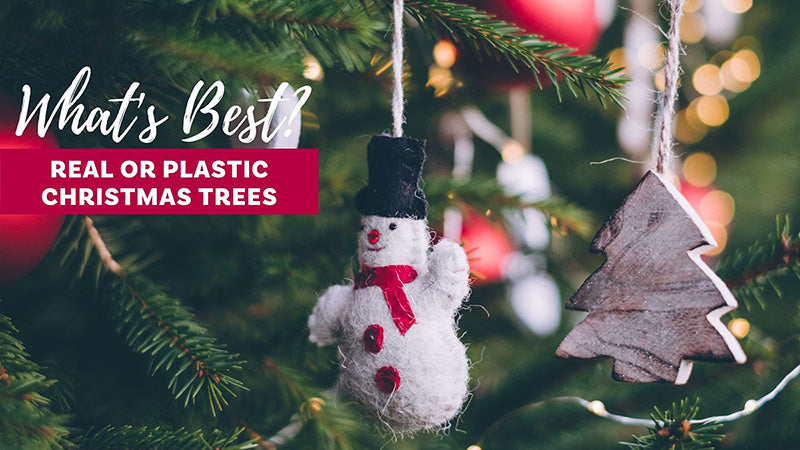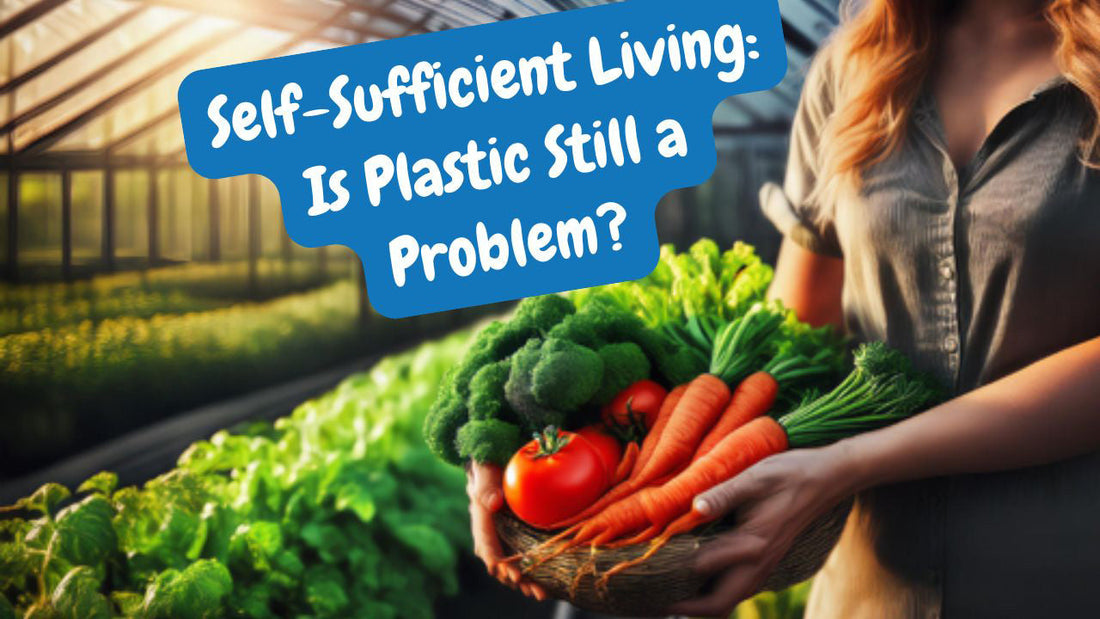You might be asking yourself this year — should I replace my old Christmas tree with a new store bought one? Perhaps you’ve just moved into a new home and you're unsure whether to choose a real tree or a plastic tree for your first Christmas? Or maybe you’re wondering if your decision to choose a real tree is actually doing more harm than good?
We’ll look at all of those options and answer the question:
“Is a real Christmas tree better than a plastic tree?”
Firstly, unless you need to replace your existing Christmas tree with a new one, the best option is to keep it — or donate it to someone that will use it. Whatever it takes to keep the plastic tree out of landfill, that’s the best option.
The next option is what to do if you’re getting a tree for the first time. Plastic or real? As this blog post is written by the owner of a plastic free store, you’re going to guess the answer will be real — but let’s weigh up the options.
Plastic Christmas Trees vs Real Trees:
SMALL AND COMPACT
 A cute little countertop tree is suitable for many people that live in apartments. But there are other, just as cute, and far more environmentally friendly options. My personal favourite? A pineapple Christmas tree. There are so many unique ways to decorate a pineapple tree: pop on some wooden sunglasses, add some fairy lights, or hang some ornaments on the pineapple leaves.
A cute little countertop tree is suitable for many people that live in apartments. But there are other, just as cute, and far more environmentally friendly options. My personal favourite? A pineapple Christmas tree. There are so many unique ways to decorate a pineapple tree: pop on some wooden sunglasses, add some fairy lights, or hang some ornaments on the pineapple leaves.
Bonus: On Christmas Day or Boxing Day if you prefer to wait — you can simply cut the pineapple up and treat yourself to some delicious fruit, add it to a smoothie, enjoy it with yoghurt for breakfast — or make it part of your Christmas dessert. Plastic free ice cream anyone? No need to pack your Pineapple tree away in the storage room. Once you've cut that delicious, juicy fruit up, simply add the skin to your compost and if you live in a suitable environment, stick the pineapple head straight into the ground. You can now enjoy the same treat again year after year.
LONG LASTING
 Buying a real tree may be financially out of reach for some people — so instead they choose the cheaper option of having a plastic tree that lasts a long time — one they can decorate with the family over and over again.
Buying a real tree may be financially out of reach for some people — so instead they choose the cheaper option of having a plastic tree that lasts a long time — one they can decorate with the family over and over again.
You know what else lasts a really long time and doesn't harm the environment? A real living plant. While it would be ideal to have a potted pine tree, if that’s not a plant that’s native to your area, than any potted plant will do. You can start off with a small potted plant and place it outside in the new year. Live in an apartment and have no room to place it outside? See the above option with a pineapple tree, or simply buy a plant that can be left inside all year round.
If you really want a pine tree, and you’re not interested in “pineapple” tree, and you have no room to store the plant inside your home come the New Year — then let your plant grow new roots — place it in the ground. Place it in your yard, watch it grow and decorate it outside each year. What a treat that will be for the kids to decorate their first tree again, and again for 20+ years to come.
BIODEGRADABLE, RECYCLABLE & REUSABLE
 While a plastic tree may be reusable, it's most definitely not biodegradable or recyclable. Plastic Christmas trees aren’t recyclable, so when they’re inevitably thrown away, they end up in landfill, going nowhere fast. Still not convinced that a real tree is more eco-friendly here are some more sustainable reasons why you should say no to a plastic tree.
While a plastic tree may be reusable, it's most definitely not biodegradable or recyclable. Plastic Christmas trees aren’t recyclable, so when they’re inevitably thrown away, they end up in landfill, going nowhere fast. Still not convinced that a real tree is more eco-friendly here are some more sustainable reasons why you should say no to a plastic tree.
- While plastic trees are typically made in China, and shipped overseas - then shipped across the country to your local store, real trees are grown in your local area. So you know when you purchase a real tree you are not only supporting your local economy, you're also supporting the local flora and fauna.
- Real trees can be reused, replanted, recycled into mulch and/or composted.
FIRE RESISTANCE
Plastic Christmas trees on the other hand, are often treated with fire-resistant chemicals — reducing the risk of your tree catching on fire. However, plastic will still burn in the optimum conditions, and when it does the fumes are toxic.
As long as a real tree has been properly maintained, meaning they are kept healthy, they are kept watered and they stay green they can be less of a fire danger. Experts also note that the placement of your real tree is also important: be sure to keep it away from heat sources and make sure you turn off the Christmas tree lights during the day and when you’re sleeping.
Want some evidence? Check out this video demonstration of a watered Christmas tree vs. a dry tree.
 There is no denying it, real trees smell beautiful and they bring a wonderful feeling to the home. But there is a downside: real trees require maintenance. Just because you’ve cut it doesn’t mean it’s not still living. A real tree will require water and without water it will start shedding its pines. For some that might a mess they’d rather not deal with.
There is no denying it, real trees smell beautiful and they bring a wonderful feeling to the home. But there is a downside: real trees require maintenance. Just because you’ve cut it doesn’t mean it’s not still living. A real tree will require water and without water it will start shedding its pines. For some that might a mess they’d rather not deal with.
In this instance a plastic tree would be more beneficial but when you weigh up all the other issues surrounding plastic trees such as the required storage in your home, the fact that one day that tree is going to landfill and will be polluting the environment long after you’ve left the planet — the inconvenience of watering the plant and cleaning up a few pine needles shouldn’t be a deterrent for getting a real tree.
There are so many other benefits to having a real tree that outweigh the maintenance issue, such as:
- Unlike plastic trees, real trees don’t require intensive carbon emission from the production and shipping. They are typically locally grown and therefore support the local economy.
- Buying a real tree you will be not only supporting your local economy, but also supporting forests, that support the air that you breathe — it’s pretty hard to argue against that!
- Once the Christmas festivities are over a real tree can be turned into mulch and reused. If it’s stored in a pot over the Christmas period it can be repotted or replanted.
- Nothing beat the smell of a fresh pine tree. You can’t compare a fresh plastic scented tree to a fresh pine scented tree. One is nostalgic as a crisp, fresh evergreen and the other — well it smells like plastic.
- Christmas trees take approximately 10 years to grow to height of 6 feet. During that growth stage, they provide a habitat for wildlife and capture carbon from the atmosphere.
Let’s be honest aside from there being less mess — there are no real benefits to having a plastic tree — it’s going to eventually end up in landfill, polluting the environment.






1 comment
I have used the same asparagus fern for a Christmas tree for the last 30 years. Coming from Canada I wanted something that at least looked like a fir tree. Yes it drops needles but it is worth the pleasure it brings.